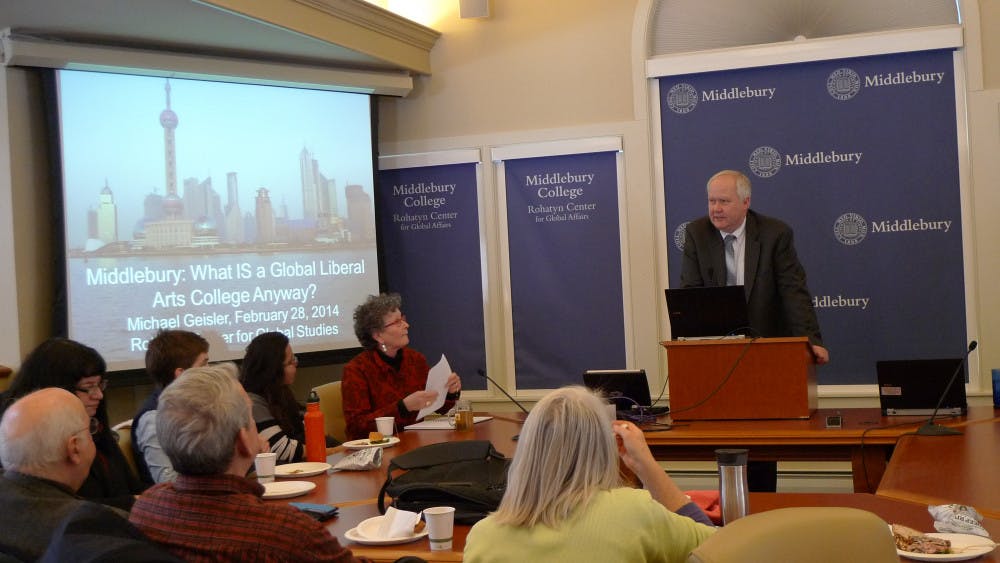On Feb. 28, students and professors gathered in the Robert A. Jones Conference Room to discuss a topic of global proportions as part of the International & Global Studies (IGS) Colloquium. They attended in hopes of garnering a fuller understanding of a particularly sweeping idea the College has often confronted in recent years: the global liberal arts education. The question on the table: why bring global studies and the liberal arts together, and how can students best take advantage of the unique opportunities and resources this system offers?
In 2007, President Ron Liebowitz and the College’s Board of Trustees “set Middlebury on a course to become the first truly global liberal arts college.” However, there seems to be no evidence that the College is the “first” to embark on such an endeavor. Whether that statement is true or not, the administration has been working extensively to bolster their argument. In 2007 alone, $392.5 million had already been raised to stake claim to being the “first.” Here again, questions resurface: why is so much money and time being put into being a “global liberal arts college?”
The event’s speaker, Michael Geisler, Vice President of Language Schools, Schools Abroad and Graduate Programs and Professor of German, is one of the most prominent voices for the College’s educational structure. Beginning his talk, he made two things very clear. First, that his views, although certainly some of the most respected, are not necessarily representative of the administration on the whole. Second, that there is no running definition for the global liberal arts college. It is difficult to value an indefinable goal, but that does not mean that interplay between global studies and a liberal arts education is without value. Geisler’s argument in support of this relationship, one that has influenced the College’s educational structure as of late, may come as a surprise to some. It is not academic or business-oriented, but a matter of basic human nature.
Geisler’s argument is best explained by looking at the liberal arts education as the “local” and global studies as the “global.” The goal to connect the local with the global to become what Geisler calls a “learner without borders.” Today, two of the most desirable professional qualities are the ability to think quickly and creatively and to speak a foreign language. As a liberal arts college with 37 sites in different countries abroad, ten (soon to be 11) languages taught at the Language Schools and 12 languages taught during regular school terms, the College is in the perfect position to impart both values.
At the most fundamental level, the purpose of a liberal arts education is to produce a well-rounded student and learner. Today, many believe this is not enough. As Geisler expressed, the addition of global studies as an integral and basic unit of a liberal arts education informs students’ sense of place within their community and within the world. The graduate, under this educational structure, is equal parts multi-purpose tool and Rosetta Stone. He or she can learn how to do most any job, anywhere. Of course, this is the theoretical graduate, but one for which a global liberal arts college is constantly striving. The remaining question, then, is simpler than the first but no less important: how do we take advantage of what seems to be a unique education?
The answer to this question comes in a circuitous way. Much of what we can do is derived from appreciation rather than action. In appreciating and understanding the educational system the administration has put in place, the resources it offers quickly become evident. Once one puts as much value in global studies as they do in the structure of a liberal arts education, the world becomes much larger, yet also more accessible. Once we are aware of the opportunities afforded us—in this case the combination of a liberal arts education (the local) and global studies (the global)—we are immediately and more fully able to take advantage of such opportunities.
Resources like the Rohatyn Center for Global Affairs and the summer language programs at the College are all perfect examples of opportunities that the College offers. According to Geisler, no other school has such a combination of resources. So then, although it is true that there is no running definition of a global liberal arts college, the drive to become one is not without value.
As Geisler believes, students at one of the best liberal arts colleges — and the best global liberal arts college — have more opportunities, and a greater variety of opportunities, than most will ever dream of having. To an extent, we havefree reign of all the College has to offer, but perhaps we should appreciate the College’s unique educational system.
As the debate continues, participants believe it is important to consider how to define the term “Global liberal arts college.”
Global Liberal Arts Education: What is the Realistic Scale of Our Education?

Comments


